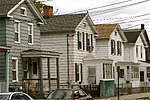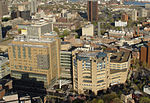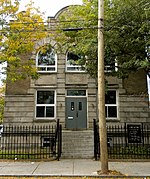Howard Avenue Historic District
Colonial Revival architecture in ConnecticutHistoric districts in New Haven, ConnecticutHistoric districts on the National Register of Historic Places in ConnecticutNRHP infobox with nocatNational Register of Historic Places in New Haven, Connecticut ... and 1 more
Queen Anne architecture in Connecticut

The Howard Avenue Historic District is a 32-acre (13 ha) historic district in The Hill neighborhood of the city of New Haven, Connecticut. Extending along Howard Avenue between Minor Street and Interstate 95, it contains an unusually high concentration of well-preserved late 19th-century middle class vernacular architecture, reflecting the area's growth at that time. It was listed on the National Register of Historic Places in 1985.
Excerpt from the Wikipedia article Howard Avenue Historic District (License: CC BY-SA 3.0, Authors, Images).Howard Avenue Historic District
Cassius Street, New Haven
Geographical coordinates (GPS) Address Nearby Places Show on map
Geographical coordinates (GPS)
| Latitude | Longitude |
|---|---|
| N 41.292138888889 ° | E -72.932611111111 ° |
Address
Cassius Street 41
06519 New Haven
Connecticut, United States
Open on Google Maps







